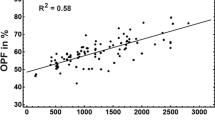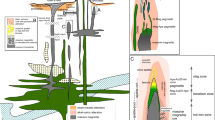Abstract—
The study of partial melting of model pyrolite showed that garnets synthesized at 7 GPa within the temperature range of 1400–1800°C were characterized by an excess in Si content (>3 f.u.) and a stable admixture of Cr2O3, and thus are pyrope–majorite–knorringite solid solutions. An increase in the Cr/Al ratio in the starting composition results in an increase of Cr/Al in garnet. With increasing temperature, the concentration of Cr2O3 in restite from partial melting decreases, whereas the chromium content in the melt increases. This is accompanied by an increase in the Cr/Al ratio in all garnets (from the zones of restite and quenched melt). Estimates of the bulk compositions of restite produced via partial melting of model pyrolite at 2.5 and 3.0 GPa showed that the concentration of chromium in restite was higher than that in the starting material. All minerals from the restite zone are characterized by high chromium concentrations, since partial melting within the spinel-depth facies results in redistribution of chromium into restite. The results we obtained show that the origin of high-Cr garnets is related to the protolith with a high Cr/Al ratio formed as a residue from partial melting in the field of spinel stability and further removed into the garnet-depth facies.







Similar content being viewed by others
REFERENCES
S. Aulbach, W. L. Griffin, N. J. Pearson, S. Y. O’Reilly, K. Kivi, and B. J. Doyle, “Mantle formation and evolution, Slave Craton: constraints from HSE abundances and Re–Os isotope systematics of sulfide inclusions in mantle xenocrysts,” Chem. Geol. 208 (1), 61–88 (2004).
R. G. Berman and L.Y. Aranovich, “Optimized standard state and solution properties of minerals: I. Model calibration for olivine, orthopyroxene, cordierite, garnet, and ilmenite in the system FeO–MgO–CaO–Al2O3–TiO2–SiO2,” Contrib. Mineral. Petrol. 126, 1–24 (1996).
V. Bulatov, G. P. Brey, and S. F. Foley, “Origin of low-Ca, high-Cr garnets by recrystallization of low–pressure harzburgites,” 5th International Kimberlite Conference, Extended Abstracts, CPRM 91, 29–31 (1991).
T. E. Bunch and K. Keil, “Chromite and ilmenite in non-chondritic meteorites,” Am. Mineral. 56, 146–157 (1971).
T. E. Bunch, K. Keil, and E. Olsen, “Mineralogy and petrology of silicate inclusions in iron meteorites,” Contrib. Mineral. Petrol. 25, 297–340 (1970).
D. Canil and K. J. Wei, “Constraints on the origin of mantle-derived low Ca garnets,” Contrib Mineral Petrol. 109, 421–430 (1992).
R. M. Davies, W. L. Griffin, S. Y. O’Reilly, and T. E. McCandless, “Inclusions in diamond from the K14 and K10 kimberlites, Buffalo Hills, Alberta, Canada: diamond growth in a plume,” Lithos 77, 99–111 (2004).
P. Deines and J. W. Harris, “New insights into the occurrence of 13C-depleted carbon in the mantle from two closely associated kimberlites: Letlhakane and Opara, Botswana,” Lithos 77, 1–4 (2004).
V. K. Garanin, K. V. Garanin, E. R. Vasil’ev, E. M. Verichev, S. I. Kostrovitsky, G. P. Kudryavtsevam and P. A. Pisarev, “Mineralogy of mantle xenoliths from the Grib diamondiferous kimberlite pipe, Arkhangelsk diamond province. Paper 1. Peridotites, pyroxenites, and eclogites,” Izv. Vyssh. Ucheb. Zaved., Geol. Razved., No. 6, 26–30 (2004).
T. Gasparik, “Experimental investigations of the origin majoritic garnet inclusions in diamonds,” Phys. Chem. Minerals 29, 170–180 (2002).
M. Gregoire, D. R. Bell, and A. P. Le Roex, “Garnet lherzolithes from the Kaapraval Craton (South Africa): trace element evidence for a metasomatic history,” J. Petrol. 44, 629–657 (2006).
W. L. Griffin, N. V. Sobolev, C. G. Ryan, N. P. Pokhilenko, T. T. Win, and E. S. Yefimova, “Trace elements in garnets and chromites: diamond formation in the Siberian lithosphere,” Lithosphere 29, 235–256 (1993).
H. S. Grütter, “The genesis of high Cr/Al garnet peridotite, with implications for cratonic crust: mantle architecture,” The Slave–Kaapvaal Workshop (Merrickville, 2001).
H. S. Grütter, J. J. Gurney, A. H. Menzies and F. Winter, “An updated classification scheme for mantle–derived garnet, for use by diamond explorers,” Lithos 77, 841–857 (2004).
C. G. Homan, “Phase diagram of Bi up to 140 kbars,” J. Phys. Chem. Solids. 36, 1249–1254 (1975).
D. A. Ionov, L. S. Doucet, and I. V. Ashchepkov, “Composition of the lithospheric mantle in the Siberian Craton: new constraints from fresh peridotites in the Udachnaya–East kimberlite,” J. Petrol. 51, 2177–2210 (2010).
T. J. Ivanic, The Chromite–Garnet Peridotite Assemblages and their Role in the Evolution of the Mantle Lithosphere. PhD Thesis (University of Edinburgh, Edinburgh, 2007).
S. E. Kesson and A. E. Ringwood, “Slab–mantle interactions: 2. The formation of diamonds.,” Chem. Geol. 78, 97–118 (1989).
S. Klemme, “The influence of Cr on the garnet–spinel transition in the Earth’s mantle: experiments in the system MgO–Cr2O3–SiO2 and thermodynamic modeling,” Lithos 77, 639–646 (2004).
A. E. Ringwood, “The chemical composition and origin of the Earth,” Adv. Earth Sci., 287–356 (1966).
A. E. Ringwood, “Synthesis of pyrope–knorringite solid-solution series,” Earth Planet. Sci. Lett. 36, 443–448 (1977).
D. J. Schulze, “Low-Ca garnet harzburgites from Kimberley, South Africa: abundance and bearing on the structure and evolution of the lithosphere,” J. Geophys. Res.: Solid Earth 617, 12513–12526 (1995).
E. A. Sirotkina, A. V. Bobrov, L. Bindi, and T. Irifune, “Phase relations and formation of chromium–rich phases in the system Mg4Si4O12–Mg3Cr2Si3O12 at 10–24 GPa and 1600°C,” Contrib. Mineral. Petrol. 169 (1), 1–14 (2015). https://doi.org/10.1007/s00410-014-1097-0
E. A. Sirotkina, A. V. Bobrov, A. A. Kargal’tsev, Yu. A. Ignat’ev, and A. A. Kadik “The influence of low aluminum concentrations on the composition and conditions of crystallization of majorite–knorringite garnets: experiment at 7.0 GPa and 1500–1700°C,” Geochem. Int. 54(7), 584–593 (2016).
N. V. Sobolev, Deep–Seated Inclusions in Kimberlites and Composition of the Upper Mantle, (Nauka, Novosibirsk, 1974) [in Russian].
N. V. Sobolev, “Diamond parageneses and problem of deep mineral formation,” Zap. Vsesoyuz. Mineral. O-va 112(4), 389–396 (1983).
T. Stachel and J.W. Harris, “Diamond precipitation and mantle metasomatism-evidence from the trace element chemistry of silicate inclusions in diamonds from Akwatia, Ghana,” Contrib. Mineral. Petrol. 129 (2–3), 143–154 (1997).
T. Stachel, K. S. Viljoen, G. Brey, and J. W. Harris, “Metasomatic processes in lherzolitic and harzburgitic domains of diamondiferous lithospheric mantle: REE in garnets from xenoliths and inclusions in diamonds,” Earth Planet Sci Lett. 159, 1–12 (1998).
A. I. Turkin and N. V. Sobolev, “Pyrope–knorringite garnets: overview of experimental data and natural parageneses,” Russ. Geol. Geophys. 50 (12), 1169–1182 (2009).
E. Van Achterbergh, W. L. Griffin, and J. Stiefenhofer, “Metasomatism in mantle xenoliths from the Letlhakane kimberlites: estimation of element fluxes,” Contrib. Mineral. Petrol. 141, 397–414 (2001).
M. F. Zhou, P. T. Robinson, J. Malpas, and Z. Li, “Podiform chromitites from the ophiolite (Southern Tibet): implications for melt/rock interaction and chromite segregation in the upper mantle,” J. Petrol. 37, 3–21 (1996).
Y. Zou and T. Irifune, “Phase relations in Mg3Cr2Si3O12 and formation of majoritic knorringite garnet at high pressure and high temperature,” J. Mineral. Petrol. Sci. 107, 197–205 (2012).
Funding
This study was supported by the Russian Science Foundation, project no. 17-17-01169.
Author information
Authors and Affiliations
Corresponding author
Additional information
Translated by A. Bobrov
Rights and permissions
About this article
Cite this article
Matrosova, E.A., Bendeliani, A.A., Bobrov, A.V. et al. Melting Relations in the Model Pyrolite at 2.5, 3.0, 7.0 GPa and 1400–1800°C: Application to the Problem of the Formation of High-Chromium Garnets. Geochem. Int. 57, 988–999 (2019). https://doi.org/10.1134/S0016702919090076
Received:
Revised:
Accepted:
Published:
Issue Date:
DOI: https://doi.org/10.1134/S0016702919090076




